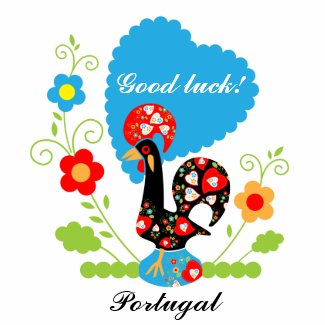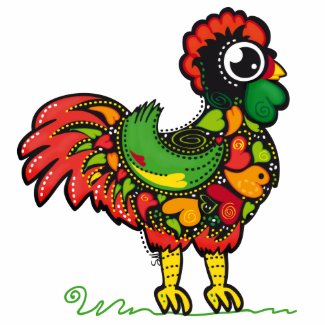Why is there the Portuguese tradition of decorating things with good luck roosters?
If you’ve ever eaten at the Portuguese-Mozambican restaurant chain, Nando’s, you most likely noticed their logo: a stylized rooster. Although a rooster makes a good logo for a restaurant specializing in chicken, there is a deeper story behind this rooster which is connected to the restaurant’s Portuguese affiliation. If you ever visit Portugal you’re likely to see a rooster in many of the souvenir shops and also in many Portuguese homes. This Portuguese rooster is called the “Galo de Barcelos”, or the Rooster of Barcelos and it is one of the unofficial emblems of Portugal.
What is the Rooster of Barcelos and how did it become the emblem of Portugal?
The image of the Portuguese rooster of Barcelos is a reference to an old legend in which a rooster miraculously saved a man’s life!
The story is set in a city called Barcelos which is located in north-west Portugal. Pilgrims often passed through Barcelos as part of their pilgrimage to the cathedral in Santiago de Compostela; A pilgrimage route also known as the Way of St James, which is still walked by devout Christians to this day. It was one such pilgrim who was instrumental in bringing the legend of the lucky rooster to life in Portugal.
Exhausted from the long walk, the pilgrim decided to rest his weary legs at an inn in Barcelos. Whilst there, a local man discovered that his silver had been stolen. Since the pilgrim was new in the town and happened to have been in the vicinity around the time when the silver went missing, an accusatory finger was swiftly pointed at the pilgrim. The pilgrim was duly arrested and set to be hanged for his dastardly deed.
Knowing he was innocent, the pilgrim made a desperate plea to appeal his case to the local judge. Agreeing grudgingly, the guards took the pilgrim to see the judge who happened to be in the middle of a sumptuous banquet. The spread was magnificent with a delicious roasted rooster sitting enticingly on the table. The pilgrim interrupted the feast and made his case. The sceptical judge ignored the pilgrim’s desperate words, saying that there was no proof of his innocence.
Certain of his innocence and unwavering in his belief in the power of a fair and loving God, the pious pilgrim fell to his knees and began fervently praying to his Maker. Spotting the roasted rooster on the table, he prayed that God would prove his innocence by making the rooster that was sitting on the platter before the judge, come to life and crow in protest should the hanging take place.
Unconvinced, but losing his appetite, the judge set the rooster aside in disgust and asked the guards to take the pilgrim away. The hanging would go ahead as planned.
The hour of the hanging of the unfortunate pilgrim arrived and just as the punishment was to be exected, a rooster’s loud crow pierced the air! Witnesses claimed to have seen the cast-aside roasted rooster standing up from the table and crowing, just as the pilgrim had prayed it would.
Realising the implications of the crow, the judge quickly regretted the hanging and commanded the pilgrim be released from the gallows immediately. Greatly relieved, the pilgrim was freed and continued on his way to Santiago de Compostelo, having been saved by the miraculous crowing roasted rooster!
Such a miracle was reminiscent of those only read about in the Bible. It was so momentous that ever since then the rooster took its proud place in the history of Portugal.
A symbol of the rooster was painted on objects to act as a reminder of this miracle and of the moral of this tale.
What exactly is the moral of this story? What does the Rooster of Barcelos represent?
The rooster of Barcelos stands for:
- Honesty: The pilgrim was innocent. He did not steal and expressed this truthfully. His honesty was eventually rewarded by God who provided a miracle that saved his life.
- Faith: If it weren’t for the pious pilgrim’s faith in God, the story may have had a different ending, so this legend demonstrates both the power of God and the importance of having faith.
- Fairness: The tale reminds us to be fair, refrain from believing unproven accusations and avoid making potentially unjust, snap judgements of our fellow man.
- Luck: Some call the rooster of Barcelos the “good luck rooster” or the “lucky rooster” because it was a rooster that saved the pilgrim’s life. As a result it is considered by some to be lucky to have his image around.
With all these positive messages behind it, it is no wonder that the rooster’s popularity has held strong to this day. And Nando’s restaurants can be proud of their logo because the traits it represents are admirable ones for any business to have!
Related articles
- Maneki Neko the Waving Lucky Cat: Why do we consider the Beckoning Cat to be lucky?
- Why do we consider the rabbit’s foot lucky?
Related Products




